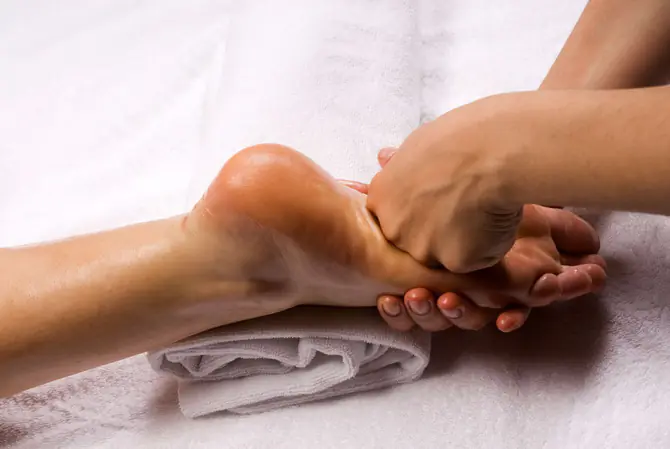Are your tired feet craving some TLC? A deep foot massage may be just what they need. Not only is it incredibly relaxing, but it can also do wonders for your overall well-being. In this guide, we'll take you step-by-step through the art of deep foot massage. No complicated jargon, just easy-to-follow instructions that anyone can understand and apply.
Content:
- What is deep foot massage?
- Benefits of deep foot massage
- Getting Started: What You'll Need
- Step by step guide to deep foot massage
- Conclusion
- FAQ
- Reviews of deep foot massage
What is deep foot massage?
Before we get into the nitty-gritty details, let's start with the basics. What exactly is a deep foot massage? Think of it as a therapy session for your feet, aimed at relieving tension, relieving pain, and improving circulation. It involves applying firm pressure to the deep layers of muscles and connective tissue in your feet.

Benefits of deep foot massage
Why should you consider a deep foot massage? Here are some good reasons:
- Pain relief: Deep tissue massage can relieve chronic foot pain caused by conditions such as plantar fasciitis or muscle strain.
- Improved blood circulation: By targeting deep tissue, this style of massage helps improve blood flow, which is vital for overall foot health.
- Stress Relief: A soothing foot massage can relieve stress and help you relax after a long day.
- Increased flexibility: This can increase the flexibility of your foot muscles and improve your range of motion.
Now that we've highlighted the benefits, let's move on to the practical aspects.
to contents ↑Getting Started: What You'll Need
To give a deep foot massage, gather these essentials:
- Comfortable chair or soft surface
- Towels
- Massage oil or lotion
- Your hands (of course!)

Step by step guide to deep foot massage
1. Find the right position
Sit comfortably and make sure the person being massaged is also relaxed. Their feet should be accessible and at a comfortable height.
2. Warm up
Start with a gentle massage of the entire foot to warm up the tissues and prepare them for deeper work. Use long, sweeping strokes.
3. Apply pressure
Use your thumbs and even your knuckles to apply pressure to the sole of your foot. Focus on any areas that feel tight.
4. Work on the arch
Move to the ball of your foot and use your thumbs to knead and press deeper. This is where many people experience a lot of stress.
How to make your own massage oil? We have the best recipes.
Read about kneading, the main technique in massage, in this article.
5. Don't forget the heel
The heel can also benefit from deep tissue work. Use your fingers to press firmly in a circular motion.
6. Address your toes
Pay attention to your toes, gently stretching and kneading each one. It can be surprisingly relaxing.
7. Repeat the exercise with the other leg
Once you have thoroughly massaged one leg, move to the other and repeat the process.
8. Finish with a gentle massage
Finish the massage with a few gentle, relaxing strokes to help your feet return to a resting state.
9. Cleaning
Make sure that you remove excess oil from the feet and that the person being massaged feels comfortable.
10. Moisturize
Encourage the patient to drink water to help flush out toxins released during the massage.
Conclusion
Deep tissue foot massage is a simple but very effective way to relieve foot pain, reduce stress and promote relaxation. With the right technique and a little practice, you can become a foot massage pro in no time.
Now let's look at some common questions about deep foot massage.
to contents ↑FAQ
1. Is deep foot massage painful?
No, it shouldn't hurt. Although it may seem stressful at times, it should always be within your comfort zone. Consult your massage therapist to adjust the pressure if necessary.
2. How long should a deep foot massage last?
A typical session lasts from 30 minutes to an hour. However, the duration may vary depending on individual preferences and needs.
3. Can I do a deep foot massage myself?
Yes you can! Although it may be a little more difficult to reach all areas, self-massage can still bring relief and relaxation. For added comfort, use a tennis ball or foot roller.
4. How often should I get a deep foot massage?
The frequency depends on your specific needs. Some people benefit from weekly sessions, while others find monthly massages sufficient. Listen to your body and adjust accordingly.
5. Are there any contraindications for deep foot massage?
Deep foot massage is generally safe for most people. However, if you have certain medical conditions or injuries, it is important to consult with a healthcare professional before getting a massage to ensure it is right for you.
Reviews of deep foot massage
Elena is a heavenly relief
The deep tissue foot massage I received was pure bliss. It's incredible how it took the stress out of my legs. After that I felt like I was walking on clouds. Highly recommend!
Olga is a stress melter
For someone who is always on his feet, deep foot massage has been a game changer. It relieved my stress and made me feel rejuvenated. It has become a regular part of my daily self-care routine.
Oleg - the pain will disappear
I suffer from chronic foot pain and deep tissue foot massage has been a lifesaver for me. The therapist's skillful hands worked wonders and I experienced instant relief. I don’t know how to thank them!
Victoria - Better than Expected
I was a little apprehensive about trying a deep foot massage, but it exceeded my expectations. The pressure was just right and I left feeling lighter and more relaxed. I'll definitely be back for more.
Inga - Necessary self-care
Now you just need to pamper yourself with a deep foot massage. It's like hitting the reset button on my tired legs. After each session, I feel a surge of strength and readiness to conquer the world.
Now that you are armed with the knowledge of deep foot massage, feel free to try it. Your feet will thank you for your care and you will feel relaxed and relieved.



